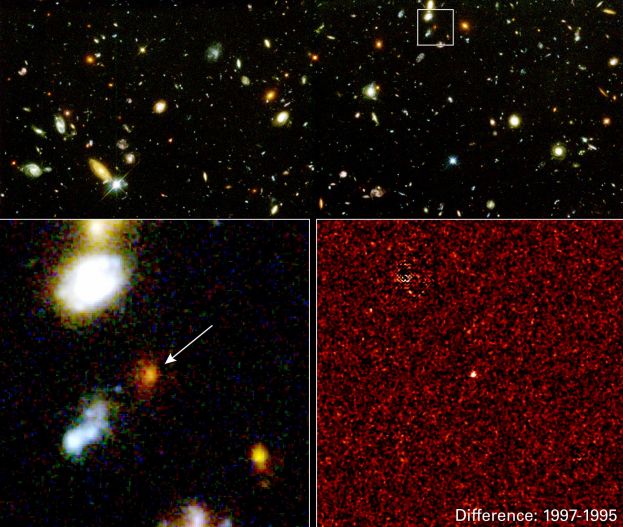
|
Credit & Copyright: Adam Riess (STScI) et al.,
NASA
Explanation:
Light from a star that exploded over 10 billion light-years away
is revealed in the panel at the lower right,
a cosmic
snapshot of the most
distant supernova.
The ancient stellar detonation
was detected
by digitally subtracting before and
after images of a faint, yellowish, elliptical galaxy
included in the Hubble Space Telescope Deep
Field image illustrated at the top and left.
Remarkable in itself as the
farthest known supernova, its measured
brightness provides astounding
evidence for
a strange universe -
one which eventually
defies gravity and expands at an
accelerating rate.
The unseen force driving
this
expansion is dubbed
dark energy
and discovering the fundamental
nature
of dark energy has been called
the challenge of this millennium.
|
January February March April May June July August September October November December |
| |||||||||||||||||||||||||||||||||||||||||||||||||||||||
NASA Web Site Statements, Warnings, and Disclaimers
NASA Official: Jay Norris. Specific rights apply.
A service of: LHEA at NASA / GSFC
& Michigan Tech. U.
Based on Astronomy Picture
Of the Day
Publications with keywords: big bang - supernova - dark energy
Publications with words: big bang - supernova - dark energy
See also:
- APOD: 2025 July 31 Á Supernova 2025rbs in NGC 7331
- APOD: 2023 October 11 Á NGC 1097: Spiral Galaxy with Supernova
- APOD: 2023 July 9 Á Doomed Star Eta Carinae
- APOD: 2023 May 22 Á Supernova Discovered in Nearby Spiral Galaxy M101
- Supernova Cannon Expels Pulsar J0002
- SN Requiem: A Supernova Seen Three Times So Far
- NGC 7814: Little Sombrero with Supernova
